Get Strong For The Slopes
Normally when your alarm rings in the dead of the night, you have to resist the temptation to smash snooze, throw your phone across the room, and snuggle deeper under the covers. But not during ski season. Those early-morning wake up calls signal that powder turns await. The mountains are calling. Are you ready?
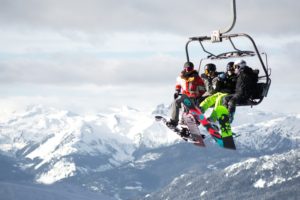
Getting in peak shape can make or break your ski/snowboard season.Improving your strength in the gym will help you weather any terrain you point your skis toward, and building stamina with conditioning will mean you can spend more time on the slopes, and less time resting in the lodge while your buddies are out there crushing it.
Hopefully, you already have a workout routine. If so, these are the exercises must include in order to improve your ski fitness. If you’re not a regular gym-goer, no worries, it’s not too late to hit the gym and work on building strength with these movements so that you can dominate the double black diamonds without hesitation this winter.
6 Essential Exercises for Ski Season
1. Pre-hab
Nothing is worse than ending your season prematurely because of an injury. I mean, sitting by the fire with a wintery beverage is nice and all, but no one wants to be stuck in the lodge while their friends explore the glades and chutes. Do yourself a favor this ski season and include some pre-hab exercises in your training to strengthening stabilizing muscles and avoid injury.
My go-to exercise for clients who ski and snowboard is a mini-band walk. Don’t underestimate this bad boy… it looks like nothin’ but you’ll be feeling the burn in your hips and butt. The mini-band walk targets your gluteus medius, the muscle on the side of your hips that is responsible for stabilizing everything down your kinetic chain (most notably, your knees). When this muscle is weak, your knees tend to collapse inward during squats, lunges, running, and other movements. This is no bueno from a safety standpoint. Generally, you want your knees to track directly over your toes during those movements, as well as when you’re outside the gym tearing up the slopes. Using the lateral band walk, you’ll activate and strengthen this important stabilizer so that you get a more effective workout, and ultimately, bulletproof your lower body against a season-ending injury.
2. Leg Strength
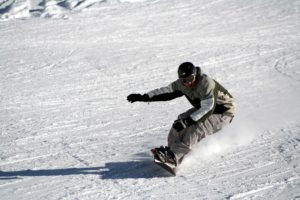
Skiing and snowboarding are obviously very demanding on your legs. Building strength with some variation of a squat is essential. For beginners (in the weight room), the goblet squat or box squat is a great place to start. For more advanced trainees, a barbell back squat or front squat will help you build legs of steel.
The trick is to use these squat variations to build serious leg strength by moving heavy weights in the 3-8 rep range. The last one or two reps should be challenging. If they’re easy, add more weight to the bar. Progress your strength by adding five to ten pounds to the bar each week, or by completing an additional set or more reps weekly. This creates “progressive overload,” constantly challenging your legs to adapt to the added stress and becoming strong as oxen in the process.
3. Unilateral leg work
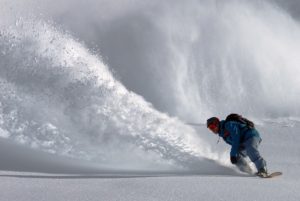
It’s essential to include unilateral (one-sided) exercises in your ski training. For one thing, most of us have a stronger side, and unilateral work helps to correct imbalances from left to right. For another thing, unilateral training improves our balance and coordination, skills that are paramount for skiers and snowboarders alike.
The best unilateral leg exercises are step ups, split squats, and lunges. Step ups tend to be the friendliest exercise for those with knee pain or a history of knee injuries since there are low-impact. Split squats can be loaded quite heavily with dumbbells, kettlebells, or a barbell, which makes them ideal for hypertrophy (muscle growth). Finally, lunges teach your lower body to absorb impact, which you’ll need to be able to do proficiently to avoid injury on the slopes.
4. Posterior chain
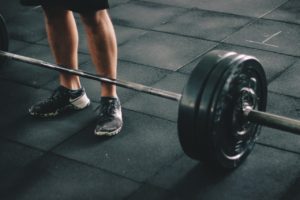
When people talk about leg strength, they mostly focus on squats and lunges, which work the front of your legs. Don’t neglect your backside! Your posterior chain is comprised of your back, glutes, hamstrings, and calves. These muscles drive all athletic movement – including anything you do on a waxed piece of wood (or two).
The hands-down best exercise for developing your posterior chain is the deadlift. Beginners can start with a single kettlebell variation, progressing to using two kettlebells (one in each hand). Advanced trainees should use a trap/hex bar or barbell variation. If your gym has a hex bar, I suggest giving it a try if you experience back pain when deadlifting. The hex bar tends to be easier on your back because the weight is in line with your body. No matter what implement you choose to use, strengthening the hip hinge pattern with a deadlift is essential in your ski training program.
5. Core: Rotation and Anti-Rotation
A strong core is the foundation of any movement. Your core includes more than just your visible abs: deep abdominal stabilizing muscles, hip flexors, and the lats on your back all contribute to core stability.
Core training should comprise more than just traditional ab exercises like crunches, though. For ski season, you’ll need to develop your ability to resist rotation and to quickly generate rotational force with your abs.
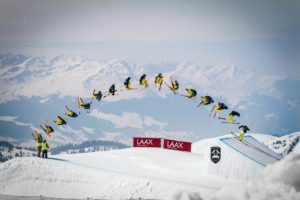 My go-to anti-rotation exercise is the Paloff Press. Using a resistance band or cable machine, you’ll stand with the anchor point off to your left or right side and grasp the handle with both hands. With your body squared up (shoulders over hips, hips over knees, knees over ankles) simply press the handle away from your chest without twisting. Easier said than done if you select the appropriate weight. It should be heavy enough to challenge you, but not so heavy that you’re forced to twist as you press.
My go-to anti-rotation exercise is the Paloff Press. Using a resistance band or cable machine, you’ll stand with the anchor point off to your left or right side and grasp the handle with both hands. With your body squared up (shoulders over hips, hips over knees, knees over ankles) simply press the handle away from your chest without twisting. Easier said than done if you select the appropriate weight. It should be heavy enough to challenge you, but not so heavy that you’re forced to twist as you press.
For rotational work, Russian twists are okay, but cable chops, landmine rotations, and heavy suitcase carries are better.
6. Power development
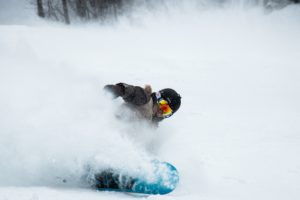 Power is the ability to express a lot of force in a short amount of time. Sprinters are powerful. Boxers are powerful. And skiers and snowboarders should be, too. It’s especially important to train for power as we age. Much like balance, power is a skill that diminishes quickly if we don’t practice it.
Power is the ability to express a lot of force in a short amount of time. Sprinters are powerful. Boxers are powerful. And skiers and snowboarders should be, too. It’s especially important to train for power as we age. Much like balance, power is a skill that diminishes quickly if we don’t practice it.
The best power exercises for ski/snowboard season are box jumps, kettlebell swings, and rotational throws.
Box jumps should not be performed for conditioning. The risk of missing the box and sending you into a cursing fit while cradling your shin is too high when you’re fatigued. Plus, power is a neurologically demanding skill to train. That means that it takes a lot out of your body. Perform box jumps in small sets, taking a full 1-2 minutes of rest to allow your central nervous system to recover between sets. These should be done in 3-5 sets of 5-6 reps before your leg workout (but after your warm up) in order to prime your lower body for resistance training.
Likewise with rotational throws. Using a soft medicine ball (slam ball), set up perpendicular to a solid wall. Hold the ball underhand in both hands and use your core to rotate toward the wall with as much force as you can, releasing the ball just in front of your body. It should bounce back to you so you can repeat another throw. Keep the sets small (3-5 throws per side) and rest for a minute or two between sets. Use as much force as you possibly can when rotating through your core.
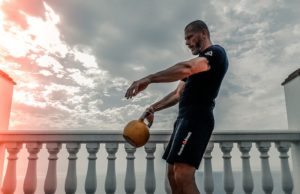
Kettlebell swings are great for power development with higher reps, and can even be used for conditioning. They’re low-impact, not neurologically demanding, and target your posterior chain. This exercise should be a staple of your ski training.
Your Ski/Snowboard Training Plan
Using these six types of exercises, you can build a training plan that will get you in peak shape for ski season. Focus 2-3 sessions per week on ski training. If your schedule allows, you can add additional upper body work to give your legs a break. Using your ski workouts every other day is ideal to avoid overtraining.
Start with a warm-up that includes dynamic stretching and pre-hab exercises like band walks. Then, prime your lower body with a power exercise like box jumps or kettlebell swings. Once you’re warmed up, hit the weights.
Use squats and deadlifts as your main strength movements. Work up to a challenging weight for a couple of sets in the 3-8 rep range if you’re using a barbell variation. Once you’ve found something heavy for the day, begin your “working” sets. Good rep schemes include 5×3, 4×5, 5×5, 4×6, and 3×8.
If you’re a beginner using a kettlebell squat or deadlift, train with higher reps. Sets of 8-12 is better since the weights you’re using will be lighter than with a barbell. In either case, the last one or two reps of each set should be challenging.
After your strength work, you can use moderate weights at higher repetitions to build muscular endurance. Think goblet squats, RDL’s, split squats, and lunges. Train these movements in the 10-20 rep range. Finish with core work.
What about conditioning?
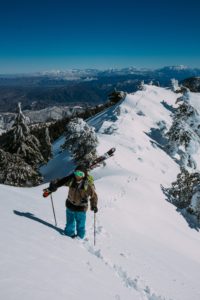
That’s a fair question. You’ll obviously need a good cardio base to spend all day on the mountain and perform your best at altitude. A 2-3 day strength training program will help build your aerobic capacity to an extent if you’re using the right amount of weight. Adding an additional long-duration cardio routine has two benefits: it will speed up recovery between lifting sessions, and it will increase your cardiac capacity so you don’t have to hit the lodge to rest in between every run.
Apres
Now that you know the six kinds of exercises you must include in your ski training, there’s nothing left to do but hit the gym. Once you build leg and core strength, rotational force, and explosive power, you’ll feel much more confident advancing your skills on the slopes. Just pray for a blustery snowstorm to dump inches (no, feet!) of that fluffy, white pow so you can put your strength and skills to the test this season.
